Biermann Ch. Handbook of Pulping and Papermaking
Подождите немного. Документ загружается.

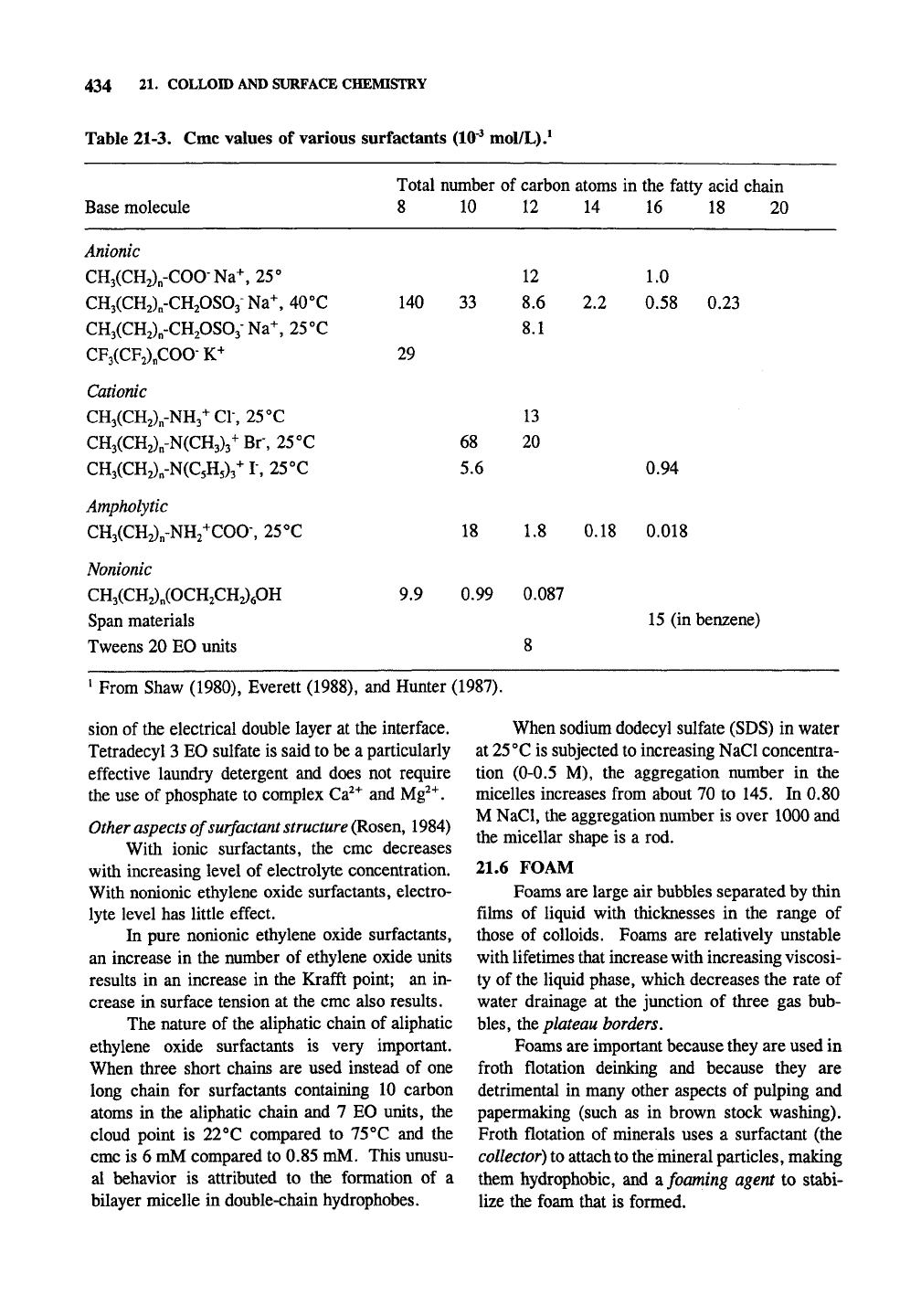
434 21. COLLOro
AND SURFACE
CHEMISTRY
Table 21-3. Cmc values of various surfactants
(10"^
mol/L).^
Base molecule
Total number of carbon atoms in the fatty acid chain
8 10 12 14 16 18 20
Anionic
CH3(CH2)n-COO-Na^, 25°
CH3(CH2)n-CH20S03Na^, 40°C
CH3(CH2)n-CH20S03-Na+, 25°C
CF3(CF2)„COO K^
Cationic
CH3(CH2)„-NH3^C1-,
25°C
CH3(CH2)„-N(CH3)3^ Br, 25 °C
CH3(CH2)„-N(C5H5)3M-, 25°C
Ampholytic
CH3(CH2)„-NH2^COO-, 25°C
Nonionic
CH3(CH2)n(OCH2CH2)60H
Span materials
Tweens 20 EO units
140 33
29
12
8.6
8.1
2.2
1.0
0.58 0.23
13
68 20
5.6
0.94
18 1.8 0.18 0.018
9.9 0.99
0.087
8
15 (in benzene)
From Shaw (1980), Everett (1988), and Hunter (1987).
sion of the electrical double layer at the interface.
Tetradecyl 3 EO sulfate is said to be a particularly
effective laundry detergent and does not require
the use of phosphate to complex
Ca^"*^
and Mg^"^.
Other aspects
of surfactant
structure
(Rosen, 1984)
With ionic surfactants, the cmc decreases
with increasing level of electrolyte concentration.
With nonionic ethylene oxide surfactants, electro-
lyte level has little effect.
In pure nonionic ethylene oxide surfactants,
an increase in the number of ethylene oxide units
results in an increase in the Krafft point; an in-
crease in surface tension at the cmc also results.
The nature of the aliphatic chain of aliphatic
ethylene oxide surfactants is very important.
When three short chains are used instead of one
long chain for surfactants containing 10 carbon
atoms in the aliphatic chain and 7 EO units, the
cloud point is 22°C compared to 75 °C and the
cmc is 6 mM compared to 0.85 mM. This unusu-
al behavior is attributed to the formation of a
bilayer micelle in double-chain hydrophobes.
When sodium dodecyl sulfate (SDS) in water
at 25 °C is subjected to increasing NaCl concentra-
tion (0-0.5 M), the aggregation number in the
micelles increases from about 70 to 145. In 0.80
M NaCl, the aggregation number is over 1000 and
the micellar shape is a rod.
21.6 FOAM
Foams are large air bubbles separated by thin
films of liquid with thicknesses in the range of
those of colloids. Foams are relatively unstable
with lifetimes that increase with increasing viscosi-
ty of the liquid phase, which decreases the rate of
water drainage at the junction of three gas bub-
bles,
\h&
plateau borders.
Foams are important because they are used in
froth flotation deinking and because they are
detrimental in many other aspects of pulping and
papermaking (such as in brown stock washing).
Froth flotation of minerals uses a surfactant (the
collector)
to attach
to
the mineral particles, making
them hydrophobic, and
?i
foaming agent to stabi-
lize the foam that is formed.
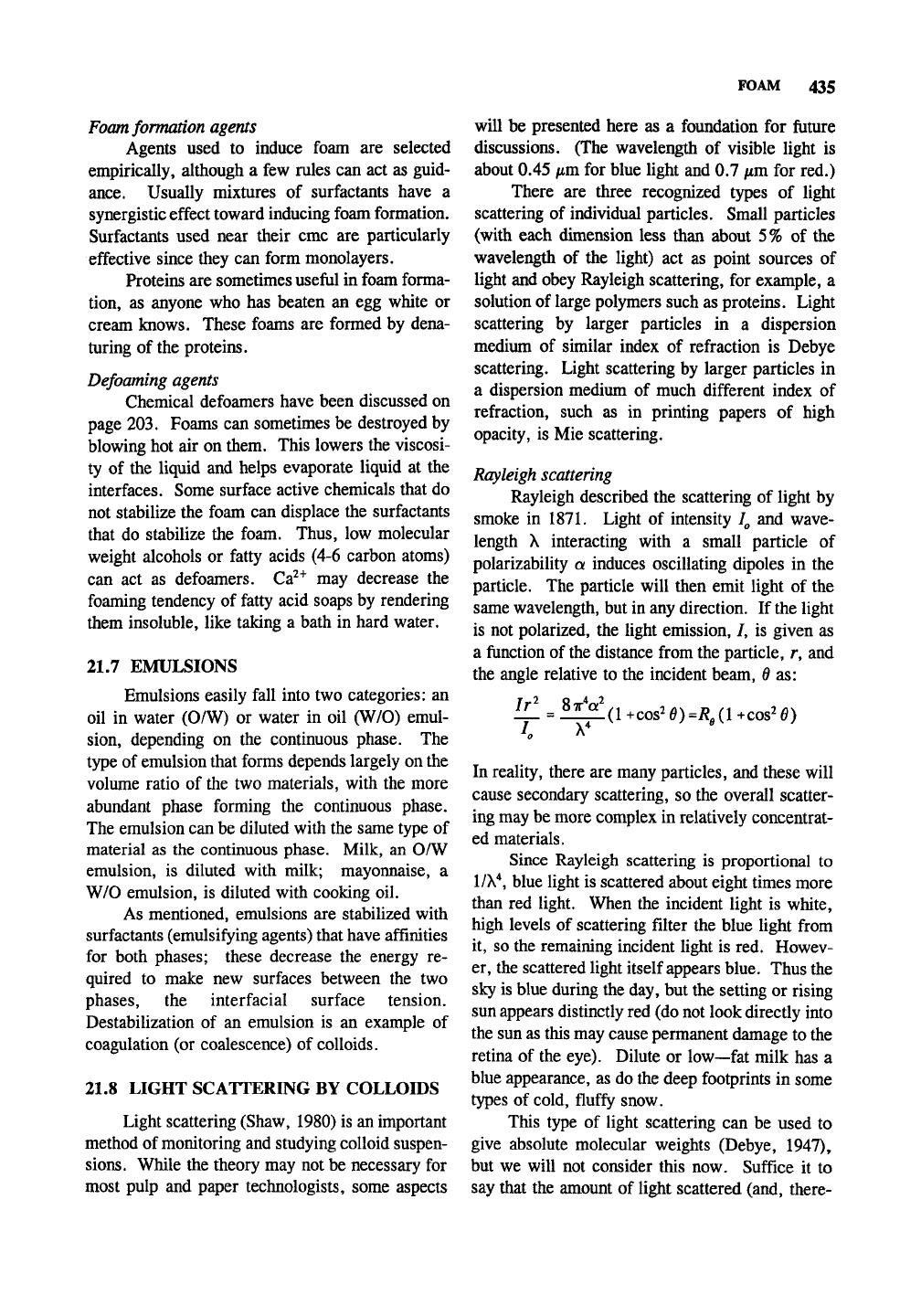
FOAM 435
Foam
formation agents
Agents used to induce foam are selected
empirically, although a few rules can act as guid-
ance.
Usually mixtures of surfactants have a
synergistic effect toward inducing foam formation.
Surfactants used near their cmc are particularly
effective since they can form monolayers.
Proteins are sometimes useful in foam forma-
tion, as anyone who has beaten an egg white or
cream knows. These foams are formed by dena-
turing of the proteins.
Defoaming agents
Chemical defoamers have been discussed on
page 203. Foams can sometimes be destroyed by
blowing hot air on them. This lowers the viscosi-
ty of the liquid and helps evaporate liquid at the
interfaces. Some surface active chemicals that do
not stabilize the foam can displace the surfactants
that do stabilize the foam. Thus, low molecular
weight alcohols or fatty acids (4-6 carbon atoms)
can act as defoamers. Ca^^ may decrease the
foaming tendency of fatty acid soaps by rendering
them insoluble, like taking a bath in hard water.
21.7 EMULSIONS
Emulsions easily fall into two categories: an
oil in water (0/W) or water in oil (W/0) emul-
sion, depending on the continuous phase. The
type of emulsion that forms depends largely on the
volume ratio of the two materials, with the more
abundant phase forming the continuous phase.
The emulsion can be diluted with the same type of
material as the continuous phase. Milk, an 0/W
emulsion, is diluted with milk; mayonnaise, a
W/0 emulsion, is diluted with cooking oil.
As mentioned, emulsions are stabilized with
surfactants (emulsifying agents) that have affinities
for both phases; these decrease the energy re-
quired to make new surfaces between the two
phases, the interfacial surface tension.
Destabilization of an emulsion is an example of
coagulation (or coalescence) of colloids.
21.8 LIGHT SCATTERING BY COLLOIDS
Light scattering (Shaw, 1980) is an important
method of monitoring and studying colloid suspen-
sions.
While the theory may not be necessary for
most pulp and paper technologists, some aspects
will be presented here as a foundation for future
discussions. (The wavelength of visible light is
about 0.45 ^m for blue light and 0.7 /itm for red.)
There are three recognized types of light
scattering of individual particles. Small particles
(with each dimension less than about 5% of the
wavelength of the light) act as point sources of
light and obey Rayleigh scattering, for example, a
solution of large polymers such as proteins. Light
scattering by larger particles in a dispersion
medium of similar index of refraction is Debye
scattering. Light scattering by larger particles in
a dispersion medium of much different index of
refraction, such as in printing papers of high
opacity, is Mie scattering.
Rayleigh scattering
Rayleigh described the scattering of light by
smoke in 1871. Light of intensity 4 and wave-
length X interacting with a small particle of
polarizability a induces oscillating dipoles in the
particle. The particle will then emit light of the
same wavelength, but in any direction. If the light
is not polarized, the light emission, /, is given as
a function of the distance from the particle, r, and
the angle relative to the incident beam, d as:
III ^^:^{l^oosH)=R^{l^co^H)
In reality, there are many particles, and these will
cause secondary scattering, so the overall scatter-
ing may be more complex in relatively concentrat-
ed materials.
Since Rayleigh scattering is proportional to
l/X"^, blue light is scattered about eight times more
than red light. When the incident light is white,
high levels of scattering filter the blue light from
it, so the remaining incident light is red. Howev-
er, the scattered light itself appears blue. Thus the
sky is blue during the day, but the setting or rising
sun appears distinctly red (do not look directly into
the sun as this may cause permanent damage to the
retina of the eye). Dilute or low—fat milk has a
blue appearance, as do the deep footprints in some
types of cold, fluffy snow.
This type of light scattering can be used to
give absolute molecular weights (Debye, 1947),
but we will not consider this now. Suffice it to
say that the amount of light scattered (and, there-
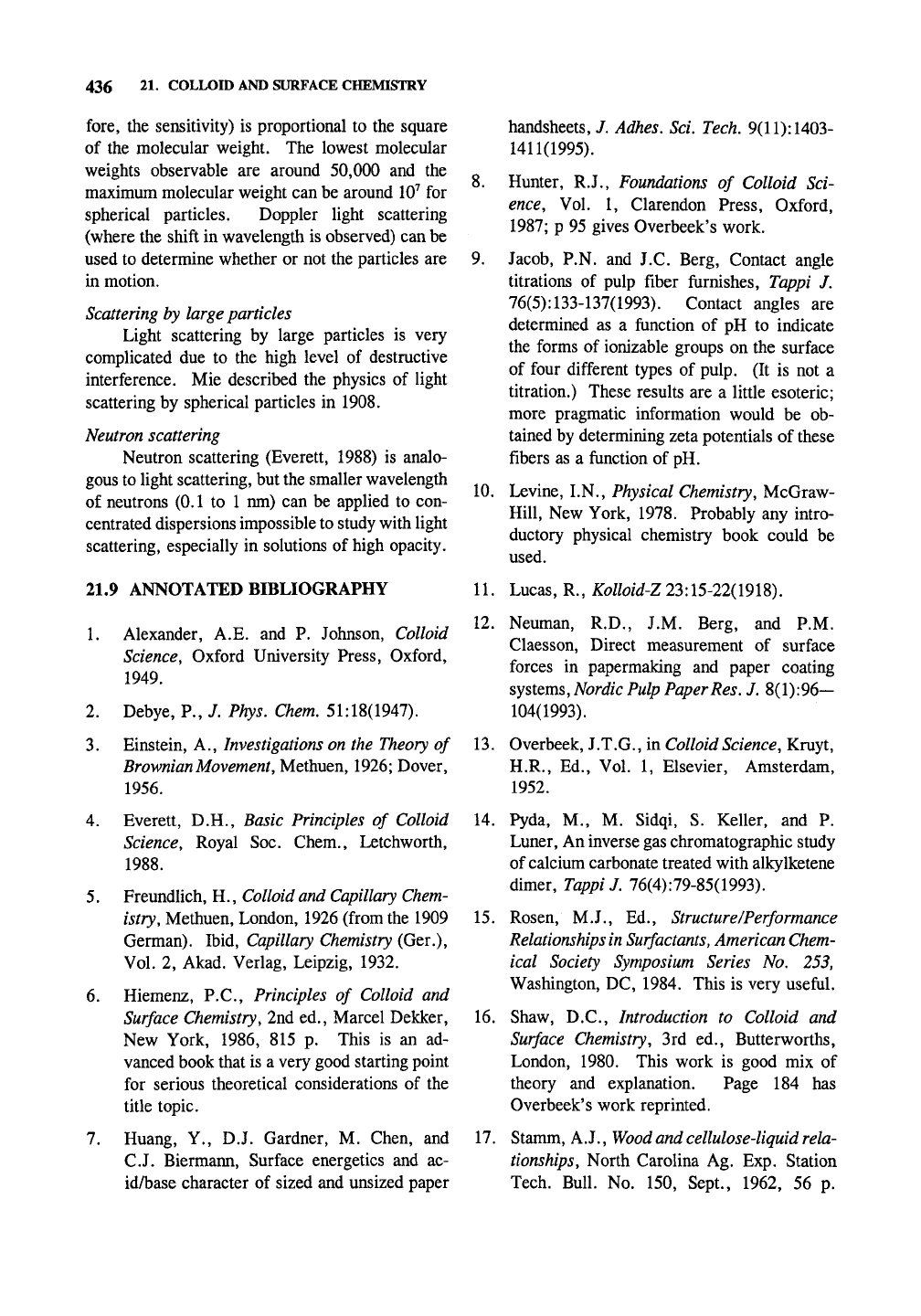
436 21. COLLOro AND SURFACE CHEMISTRY
fore,
the sensitivity) is proportional to the square
of the molecular weight. The lowest molecular
weights observable are around 50,000 and the
maximum molecular weight can be around 10^ for
spherical particles. Doppler light scattering
(where the shift in wavelength is observed) can be
used to determine whether or not the particles are
in motion.
Scattering
by
large
particles
Light scattering by large particles is very
complicated due to the high level of destructive
interference. Mie described the physics of light
scattering by spherical particles in 1908.
Neutron
scattering
Neutron scattering (Everett, 1988) is analo-
gous to light scattering, but the smaller wavelength
of neutrons (0.1 to 1 nm) can be applied to con-
centrated dispersions impossible to study with light
scattering, especially in solutions of high opacity.
21.9 ANNOTATED BIBLIOGRAPHY
1.
Alexander, A.E. and P. Johnson, Colloid
Science, Oxford University Press, Oxford,
1949.
2.
Debye, P., /. Phys. Chem. 51:18(1947).
3.
Einstein, A.,
Investigations
on the
Theory
of
BrownianMovement, Methuen, 1926; Dover,
1956.
4.
Everett, D.H., Basic Principles of Colloid
Science, Royal Soc. Chem., Letchworth,
1988.
5. Freundlich, H.,
Colloid and Capillary
Chem-
istry, Methuen, London, 1926 (from the 1909
German). Ibid, Capillary Chemistry (Ger.),
Vol. 2, Akad. Verlag, Leipzig, 1932.
6. Hiemenz, P.C., Principles of Colloid and
Surface Chemistry, 2nd ed.. Marcel Dekker,
New York, 1986, 815 p. This is an ad-
vanced book that is a very good starting point
for serious theoretical considerations of the
title topic.
7.
Huang, Y., D.J. Gardner, M. Chen, and
C.J. Biermann, Surface energetics and ac-
id/base character of sized and unsized paper
handsheets, J, Adhes. Sci. Tech.
9(11):
1403-
1411(1995).
8. Hunter, R.J., Foundations of Colloid
Sci-
ence, Vol. 1, Clarendon Press, Oxford,
1987;
p 95 gives Overbeek's work.
9. Jacob, P.N. and J.C. Berg, Contact angle
titrations of pulp fiber furnishes, Tappi J,
76(5):
133-137(1993).
Contact angles are
determined as a function of pH to indicate
the forms of ionizable groups on the surface
of four different types of pulp. (It is not a
titration.) These results are a little esoteric;
more pragmatic information would be ob-
tained by determining zeta potentials of these
fibers as a function of pH.
10.
Levine, LN., Physical Chemistry, McGraw-
Hill, New York, 1978. Probably any intro-
ductory physical chemistry book could be
used.
11.
Lucas, R.,
Kolloid-Z2?>'A5-22{\9\%).
12.
Neuman, R.D., J.M. Berg, and P.M.
Claesson, Direct measurement of surface
forces in papermaking and paper coating
systems,
Nordic Pulp
Paper Res. J. 8(1):96—
104(1993).
13.
Overbeek, J.T.G., in
Colloid
Science,
Kruyt,
H.R., Ed., Vol. 1, Elsevier, Amsterdam,
1952.
14.
Pyda, M., M. Sidqi, S. Keller, and P.
Luner, An inverse gas chromatographic study
of calcium carbonate treated with alkylketene
dimer, Tappi J. 76(4):79-85(1993).
15.
Rosen, M.J., Ed., Structure/Performance
Relationships in
Surfactants,
American
Chem-
ical Society Symposium Series No. 253,
Washington, DC, 1984. This is very useful.
16.
Shaw, D.C., Introduction to Colloid and
Surface Chemistry, 3rd ed., Butterworths,
London, 1980. This work is good mix of
theory and explanation. Page 184 has
Overbeek's work reprinted.
17.
Stamm, A. J.,
Wood and cellulose-liquid
rela-
tionships. North Carolina Ag. Exp. Station
Tech. Bull. No. 150, Sept., 1962, 56 p.
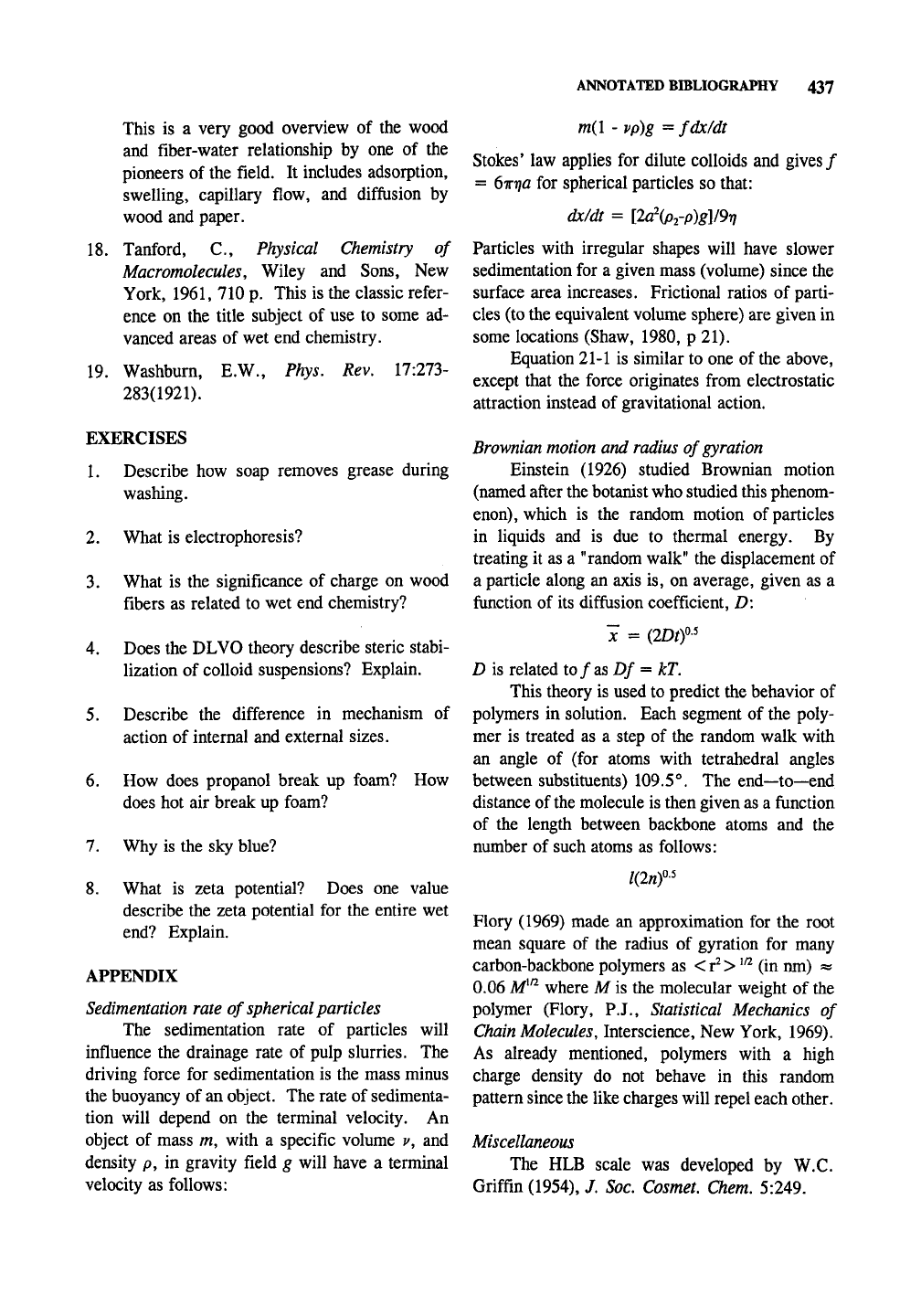
ANNOTATED BIBLIOGRAPHY 437
This is a very good overview of the wood
and fiber-water relationship by one of the
pioneers of the field. It includes adsorption,
swelling, capillary flow, and diffusion by
wood and paper.
18.
Tanford, C, Physical Chemistry of
Macromolecules, Wiley and Sons, New
York, 1961, 710 p. This is the classic refer-
ence on the title subject of use to some ad-
vanced areas of wet end chemistry.
19.
Washburn, E.W., Phys. Rev, 17:273-
283(1921).
EXERCISES
1.
Describe how soap removes grease during
washing.
2.
What is electrophoresis?
3.
What is the significance of charge on wood
fibers as related to wet end chemistry?
4.
Does the DLVO theory describe steric stabi-
lization of colloid suspensions? Explain.
5.
Describe the difference in mechanism of
action of internal and external sizes.
6. How does propanol break up foam? How
does hot air break up foam?
7.
Why is the sky blue?
8. What is zeta potential? Does one value
describe the zeta potential for the entire wet
end? Explain.
APPENDIX
Sedimentation rate of spherical particles
The sedimentation rate of particles will
influence the drainage rate of pulp slurries. The
driving force for sedimentation is the mass minus
the buoyancy of an object. The rate of sedimenta-
tion will depend on the terminal velocity. An
object of mass m, with a specific volume v, and
density p, in gravity field g will have a terminal
velocity as follows:
m(\ - vp)g = fdx/dt
Stokes' law applies for dilute colloids and gives/
= 67nya for spherical particles so that:
dx/dt =
[2a^(j>2-p)gV9't]
Particles with irregular shapes will have slower
sedimentation for a given mass (volume) since the
surface area increases. Frictional ratios of parti-
cles (to the equivalent volume sphere) are given in
some locations (Shaw, 1980, p 21).
Equation 21-1 is similar to one of the above,
except that the force originates from electrostatic
attraction instead of gravitational action.
Brownian
motion and radius of gyration
Einstein (1926) studied Brownian motion
(named after the botanist who studied this phenom-
enon),
which is the random motion of particles
in liquids and is due to thermal energy. By
treating it as a "random walk" the displacement of
a particle along an axis is, on average, given as a
function of its diffusion coefficient, D\
I = {IDtf
D is related to/as Df = kT.
This theory is used to predict the behavior of
polymers in solution. Each segment of the poly-
mer is treated as a step of the random walk with
an angle of (for atoms with tetrahedral angles
between substituents) 109.5°. The end—to—end
distance of
the
molecule is then given as a function
of the length between backbone atoms and the
number of such atoms as follows:
l{2nf'
Flory (1969) made an approximation for the root
mean square of the radius of gyration for many
carbon-backbone polymers as <r^> '^ (in nm) »
0.06
M^'^
where M is the molecular weight of the
polymer (Flory, P.J., Statistical Mechanics of
Chain
Molecules, Interscience, New York, 1969).
As already mentioned, polymers with a high
charge density do not behave in this random
pattern since the like charges will repel each other.
Miscellaneous
The HLB scale was developed by W.C.
Griffin (1954), J. Soc. Cosmet. Chem. 5:249.
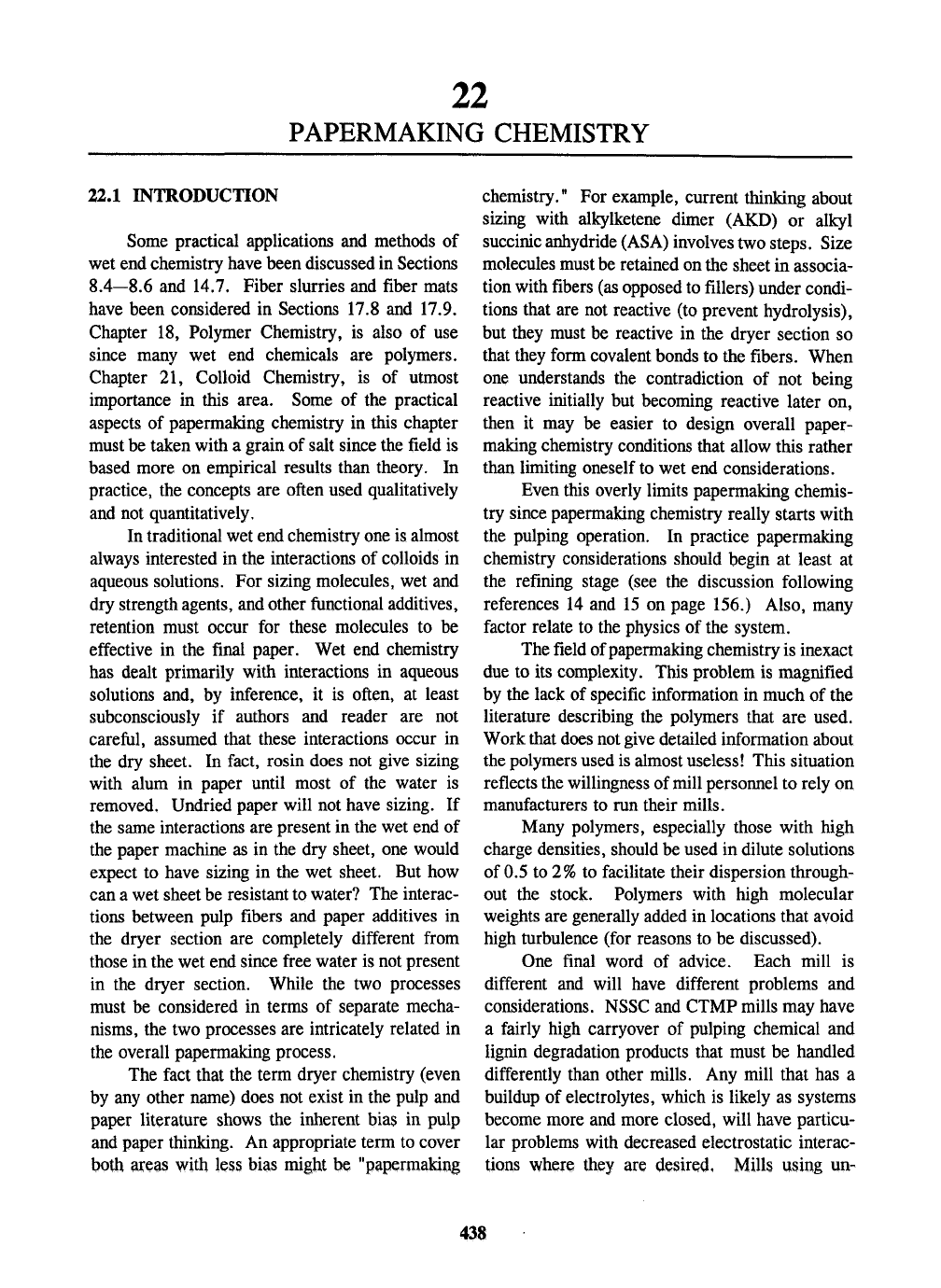
22
PAPERMAKING CHEMISTRY
22.1 INTRODUCTION
Some practical applications and methods of
wet end chemistry have been discussed in Sections
8.4—8.6
and 14.7. Fiber slurries and fiber mats
have been considered in Sections 17.8 and 17.9.
Chapter 18, Polymer Chemistry, is also of use
since many wet end chemicals are polymers.
Chapter 21, Colloid Chemistry, is of utmost
importance in this area. Some of the practical
aspects of papermaking chemistry in this chapter
must be taken with a grain of salt since the field is
based more on empirical results than theory. In
practice, the concepts are often used qualitatively
and not quantitatively.
In traditional wet end chemistry one is almost
always interested in the interactions of colloids in
aqueous solutions. For sizing molecules, wet and
dry strength agents, and other ftinctional additives,
retention must occur for these molecules to be
effective in the final paper. Wet end chemistry
has dealt primarily with interactions in aqueous
solutions and, by inference, it is often, at least
subconsciously if authors and reader are not
careful, assumed that these interactions occur in
the dry sheet. In fact, rosin does not give sizing
with alum in paper until most of the water is
removed. Undried paper will not have sizing. If
the same interactions are present in the wet end of
the paper machine as in the dry sheet, one would
expect to have sizing in the wet sheet. But how
can a wet sheet be resistant to water? The interac-
tions between pulp fibers and paper additives in
the dryer section are completely different from
those in the wet end since free water is not present
in the dryer section. While the two processes
must be considered in terms of separate mecha-
nisms, the two processes are intricately related in
the overall papermaking process.
The fact that the term dryer chemistry (even
by any other name) does not exist in the pulp and
paper literature shows the inherent bias in pulp
and paper thinking. An appropriate term to cover
both areas with less bias might be "papermaking
chemistry." For example, current thinking about
sizing with alkylketene dimer (AKD) or alkyl
succinic anhydride (ASA) involves two steps. Size
molecules must be retained on the sheet in associa-
tion with fibers (as opposed to fillers) under condi-
tions that are not reactive (to prevent hydrolysis),
but they must be reactive in the dryer section so
that they form covalent bonds to the fibers. When
one understands the contradiction of not being
reactive initially but becoming reactive later on,
then it may be easier to design overall paper-
making chemistry conditions that allow this rather
than limiting oneself to wet end considerations.
Even this overly limits papermaking chemis-
try since papermaking chemistry really starts with
the pulping operation. In practice papermaking
chemistry considerations should begin at least at
the refining stage (see the discussion following
references 14 and 15 on page 156.) Also, many
factor relate to the physics of the system.
The field of papermaking chemistry is inexact
due to its complexity. This problem is magnified
by the lack of specific information in much of the
literature describing the polymers that are used.
Work that does not give detailed information about
the polymers used is almost
useless!
This situation
reflects the willingness of mill personnel to rely on
manufacturers to run their mills.
Many polymers, especially those with high
charge densities, should be used in dilute solutions
of 0.5 to 2% to facilitate their dispersion through-
out the stock. Polymers with high molecular
weights are generally added in locations that avoid
high turbulence (for reasons to be discussed).
One final word of advice. Each mill is
different and will have different problems and
considerations. NSSC and CTMP mills may have
a fairly high carryover of pulping chemical and
lignin degradation products that must be handled
differently than other mills. Any mill that has a
buildup of electrolytes, which is likely as systems
become more and more closed, will have particu-
lar problems with decreased electrostatic interac-
tions where they are desired, Mills using un-
438

INTRODUCTION 439
bleached fiber may be able to take advantage of
the lignin of their pulps in papermaking chemistry
systems, although this technique needs much
development (Zhuang and Biermann, 1993).
Fines
Fines
are the materials that pass through a 76
lim (200 mesh) screen. This is essentially the
definition, since the Britt jar test and Bauer—
McNett schemes both use these screens. Fines
include pulp fines (parenchyma cells, especially
from hardwoods and nonwood pulps, and small
fiber fragments), fillers, and most dissolved or
colloidal additives. Materials larger than this are
fibers and large fiber fragments. Fines typically
have five times the surface area of fibers per given
unit of
weight,
but it may be as much as ten times.
Fines also tend to swell and adsorb more water
than fibers. Some typical fines levels in stock are
40—60%
for newsprint, 30—55% for fine papers,
and less than
25%
for linerboard.
Anionic trash
refers to materials that contrib-
ute to the anionic charge of the stock, but are not
intentionally added components. This might in-
clude lignin degradation products, pulping or
bleaching chemicals, or materials carried over
from secondary fiber, depending on the mill.
The cations associated with these materials
are most apt to be
Na"^
ion, which, as we will see,
do not (at low concentrations) have a marked
affect
on
papermaking chemistry—thus, the lack of
the term cationic trash.
Fillers
In addition to the fillers discussed in Section
8.4, some manufactures have plastic or plastic-
encapsulated fillers. Others include aluminum
oxide—based materials.
The shape of fillers is important for several
reasons. It affects the light scattering properties
(opacity and gloss), the calendering process, the
drying rate, and the air permeability of the paper.
The specific surface area of fillers ranges from 2
to 40 mVg for most fillers and is inversely related
to particle size. Small particles, however, have a
high tendency to aggregate. Ironically, larger
diameter fillers may be more difficult to retain
(although they will require lower levels of reten-
tion aids) due to their decreased specific surface.
On the other hand, furnishes containing fillers of
small particles are more difficult to give internal
sizing to (in the final sheet) since there is a higher
surface area competing for the sizing agent.
Polyacrylic acid or polyphosphates are often
used, with anchoring cations, to decrease the zeta
potential (described below) of some fillers. This
helps disperse the fillers but may interfere with
their aggregation (retention) during drainage. It
may be usefiil to characterize each additive in
terms of the amount of a standard polymer re-
quired to cause
flocculation
in order to see if the
raw materials change with time, as when a prob-
lem occurs. Even if changes do not occur in the
raw materials, this knowledge will allow one to
focus on the real problem.
Kaolin clay
Kaolin clay has an empirical formula of
Al203-2Si02-2H20. Although there are several
forms of the mineral, kaolinite is the most abun-
dant of
these.
It occurs in three morphologies that
are available to the pulp and paper industry; these
are nondelaminated (booklet or standard hydrous),
delaminated (platelet), and calcined.
Nondelaminated clay occurs in a stack (much
like a roll of coins) of hexagonal (more or less)
plates (Fig. 22-1). Partially delaminated clay is
often used in wet end filler applications.
These stacks are broken
into
individual plates
by the process of delamination (Figs. 22-2 and 22-
3).
Delaminated clay of ultrafine particle sizes is
used in coatings to give high gloss. Fine particle
sizes give lower gloss. Coarse particles are used
for matte
finished
sheets.
Calcined clay is made by heating clay (as in
a lime kiln) at approximately UOO°C. The struc-
ture is changed somewhat to become more porous;
it is of lower overall density than standard clays
(Fig. 22-4) [the material density (excluding the
pores) has changed very
little].
The brightness
may be as high as 92—94% in premium grades
(calcining increases the brightness by 3—4 points).
Calcined clay is appreciably more abrasive (due to
the formation of some mullite) and expensive than
untreated clay. The opacity of calcined clay is
higher than that of uncalcined clay due to the
increase number of clay—air interfaces.
According to the China Clay Producers
Association, the U,S state of Georgia produces
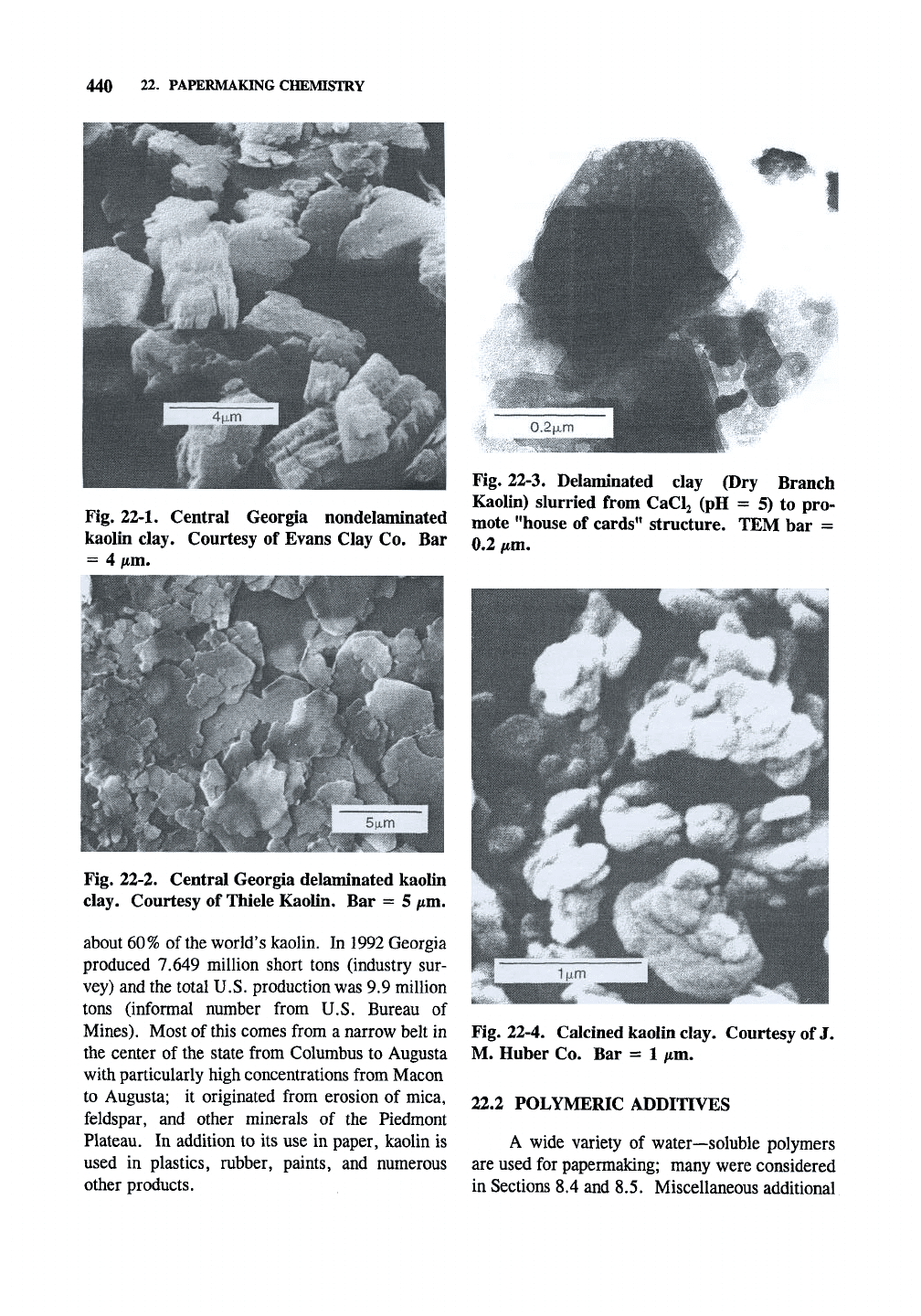
440 22. PAPERMAKING CHEMISTRY
Fig. 22-1. Central Georgia nondelaminated
kaolin clay. Courtesy of Evans Clay Co. Bar
= 4 fim.
Fig. 22-2. Central Georgia delaminated kaolin
clay. Courtesy of Thiele Kaolin. Bar = 5 fim.
about 60% of
the
world's kaolin. In 1992 Georgia
produced 7.649 million short tons (industry sur-
vey) and the total U.S. production was 9.9 million
tons (informal number from U.S. Bureau of
Mines). Most of this comes from a narrow belt in
the center of the state from Columbus to Augusta
with particularly high concentrations from Macon
to Augusta; it originated from erosion of mica,
feldspar, and other minerals of the Piedmont
Plateau. In addition to its use in paper, kaolin is
used in plastics, rubber, paints, and numerous
other products.
Fig. 22-3. Delaminated clay (Dry Branch
Kaolin) slurried from CaClj (pH = 5) to pro-
mote "house of cards" structure. TEM bar =
0.2 ^m.
Fig. 22-4. Calcined kaolin clay. Courtesy of J.
M. Huber Co. Bar = 1 fim.
22.2 POLYMERIC ADDITIVES
A wide variety of water—soluble polymers
are used for papermaking; many were considered
in Sections 8.4 and 8.5. Miscellaneous additional
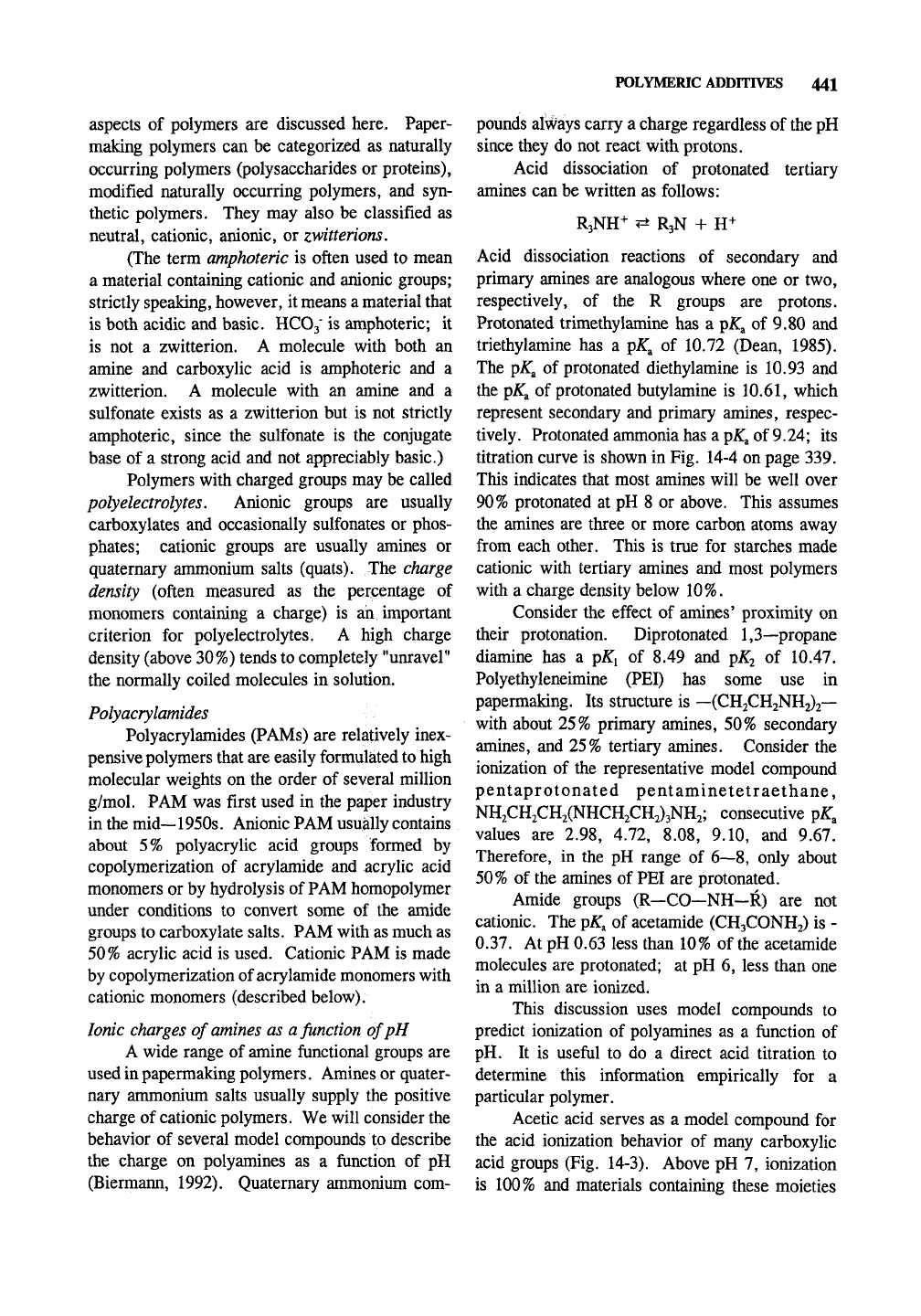
POLYMERIC ADDITIVES 441
aspects of polymers are discussed here. Paper-
making polymers can be categorized as naturally
occurring polymers (polysaccharides or proteins),
modified naturally occurring polymers, and syn-
thetic polymers. They may also be classified as
neutral, cationic, anionic, or zwitterions.
(The term amphoteric is often used to mean
a material containing cationic and anionic groups;
strictly speaking, however, it means a material that
is both acidic and basic.
HCO3"
is amphoteric; it
is not a zwitterion. A molecule with both an
amine and carboxylic acid is amphoteric and a
zwitterion. A molecule with an amine and a
sulfonate exists as a zwitterion but is not strictly
amphoteric, since the sulfonate is the conjugate
base of a strong acid and not appreciably basic.)
Polymers with charged groups may be called
poly electrolytes. Anionic groups are usually
carboxylates and occasionally sulfonates or phos-
phates; cationic groups are usually amines or
quaternary ammonium salts (quats). The charge
density (often measured as the percentage of
monomers containing a charge) is an important
criterion for polyelectrolytes. A high charge
density (above 30%) tends to completely "unravel"
the normally coiled molecules in solution.
Polyacrylamides
Polyacrylamides (PAMs) are relatively inex-
pensive polymers that are easily formulated to high
molecular weights on the order of several million
g/mol. PAM was first used in the paper industry
in the mid—1950s. Anionic PAM usually contains
about 5% polyacrylic acid groups formed by
copolymerization of acrylamide and acrylic acid
monomers or by hydrolysis of PAM homopolymer
under conditions to convert some of the amide
groups to carboxylate salts. PAM with as much as
50%
acrylic acid is used. Cationic PAM is made
by copolymerization of acrylamide monomers with
cationic monomers (described below).
Ionic charges of
amines
as
a
function ofpH
A wide range of amine functional groups are
used in papermaking polymers. Amines or quater-
nary ammonium salts usually supply the positive
charge of cationic polymers. We will consider the
behavior of several model compounds to describe
the charge on polyamines as a ftmction of pH
(Biermann, 1992). Quaternary ammonium com-
pounds always carry a charge regardless of the pH
since they do not react with protons.
Acid dissociation of protonated tertiary
amines can be written as follows:
R3NH+
<^
R3N + H+
Acid dissociation reactions of secondary and
primary amines are analogous where one or two,
respectively, of the R groups are protons.
Protonated trimethylamine has a pJ^^ of 9.80 and
triethylamine has a p^, of 10.72 (Dean, 1985).
The pK^ of protonated diethylamine is 10.93 and
the pjfiTa of protonated butylamine is
10.61,
which
represent secondary and primary amines, respec-
tively. Protonated ammonia has a
pATa
of 9.24; its
titration curve is shown in Fig. 14-4 on page 339.
This indicates that most amines will be well over
90%
protonated at pH 8 or above. This assumes
the amines are three or more carbon atoms away
from each other. This is true for starches made
cationic with tertiary amines and most polymers
with a charge density below 10%.
Consider the effect of amines' proximity on
their protonation. Diprotonated
1,3—propane
diamine has a pKi of 8.49 and p^2 of 10.47.
Polyethyleneimine (PEI) has some use in
papermaking. Its structure is —(CH2CH2NH2)2—
with about 25% primary amines, 50% secondary
amines, and 25% tertiary amines. Consider the
ionization of the representative model compound
pentaprotonated pentaminetetraethane,
NH2CH2CH2(NHCH2CH2)3NH2; consecutive p^,
values are 2.98, 4.72, 8.08, 9.10, and 9.67.
Therefore, in the pH range of 6—8, only about
50%
of the amines of PEI are protonated.
Amide groups (R—CO—NH—R) are not
cationic. The p^^ of acetamide (CH3CONH2) is -
0.37. At pH 0.63 less than 10% of the acetamide
molecules are protonated; at pH 6, less than one
in a million are ionized.
This discussion uses model compounds to
predict ionization of polyamines as a function of
pH.
It is useful to do a direct acid titration to
determine this information empirically for a
particular polymer.
Acetic acid serves as a model compound for
the acid ionization behavior of many carboxylic
acid groups (Fig. 14-3). Above pH 7, ionization
is 100% and materials containing these moieties
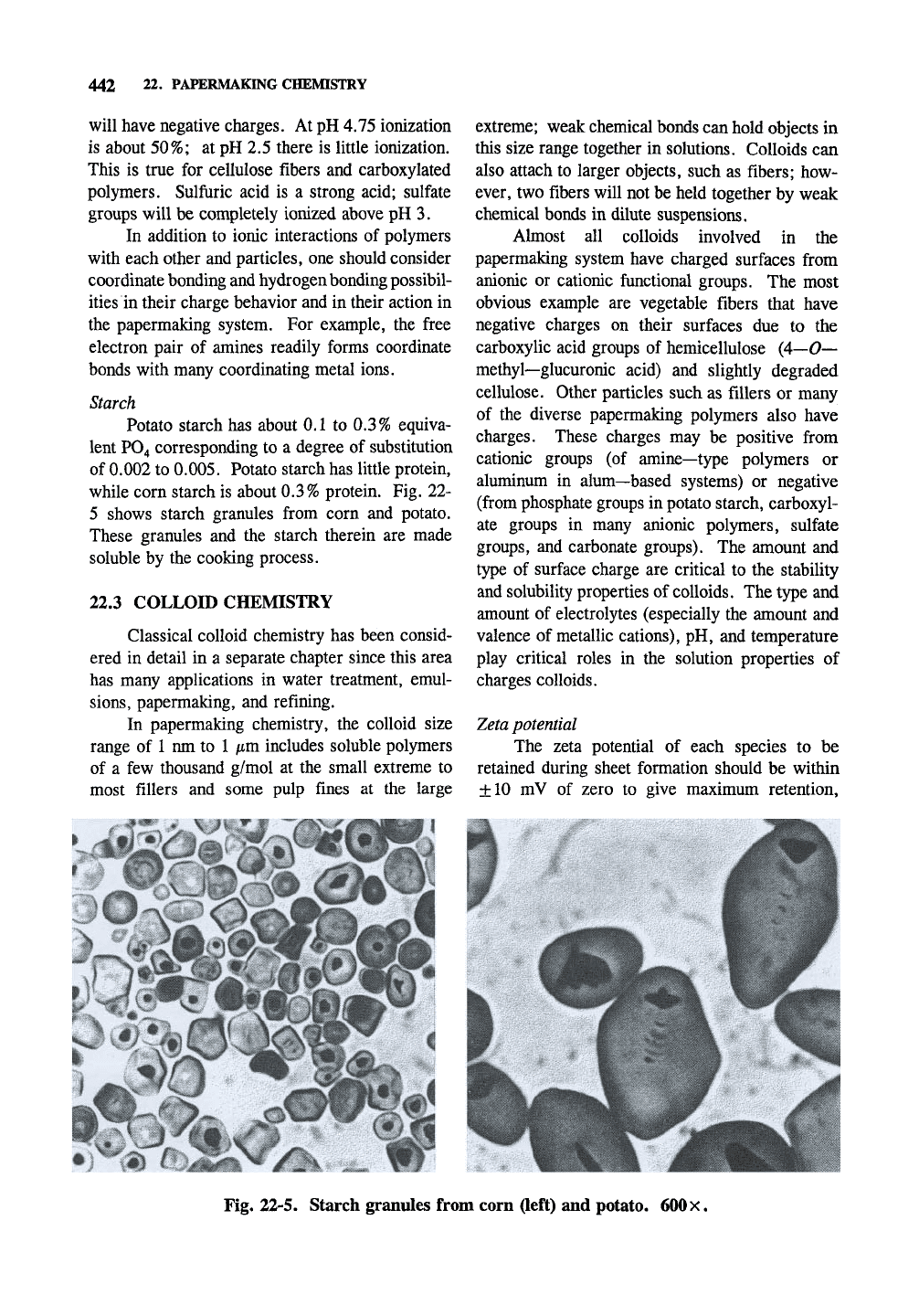
442 22. PAPERMAKING CHEMISTRY
will have negative charges. At pH 4.75 ionization
is about 50%; at pH 2.5 there is little ionization.
This is true for cellulose fibers and carboxylated
polymers. Sulfuric acid is a strong acid; sulfate
groups will be completely ionized above pH 3.
In addition to ionic interactions of polymers
with each other and particles, one should consider
coordinate bonding and hydrogen bonding possibil-
ities in their charge behavior and in their action in
the papermaking system. For example, the free
electron pair of amines readily forms coordinate
bonds with many coordinating metal ions.
Starch
Potato starch has about 0.1 to 0.3% equiva-
lent PO4 corresponding to a degree of substitution
of 0.002 to 0.005. Potato starch has little protein,
while corn starch is about 0.3% protein. Fig. 22-
5 shows starch granules from corn and potato.
These granules and the starch therein are made
soluble by the cooking process.
22.3 COLLOID CHEMISTRY
Classical colloid chemistry has been consid-
ered in detail in a separate chapter since this area
has many applications in water treatment, emul-
sions,
papermaking, and refining.
In papermaking chemistry, the colloid size
range of
1
nm to 1 /xm includes soluble polymers
of a few thousand g/mol at the small extreme to
most fillers and some pulp fines at the large
extreme; weak chemical bonds can hold objects in
this size range together in solutions. Colloids can
also attach to larger objects, such as fibers; how-
ever, two fibers will not be held together by weak
chemical bonds in dilute suspensions.
Almost all colloids involved in the
papermaking system have charged surfaces from
anionic or cationic functional groups. The most
obvious example are vegetable fibers that have
negative charges on their surfaces due to the
carboxylic acid groups of hemicellulose (4—0—
methyl—glucuronic acid) and slightly degraded
cellulose. Other particles such as fillers or many
of the diverse papermaking polymers also have
charges. These charges may be positive from
cationic groups (of amine—type polymers or
aluminum in alum—based systems) or negative
(from phosphate groups in potato starch, carboxyl-
ate groups in many anionic polymers, sulfate
groups, and carbonate groups). The amount and
type of surface charge are critical to the stability
and solubility properties of
colloids.
The type and
amount of electrolytes (especially the amount and
valence of metallic cations), pH, and temperature
play critical roles in the solution properties of
charges colloids.
Zeta potential
The zeta potential of each species to be
retained during sheet formation should be within
±10 mV of zero to give maximum retention.
•) \^ ^.
Fig. 22-5. Starch granules from corn (left) and potato.
600
x.
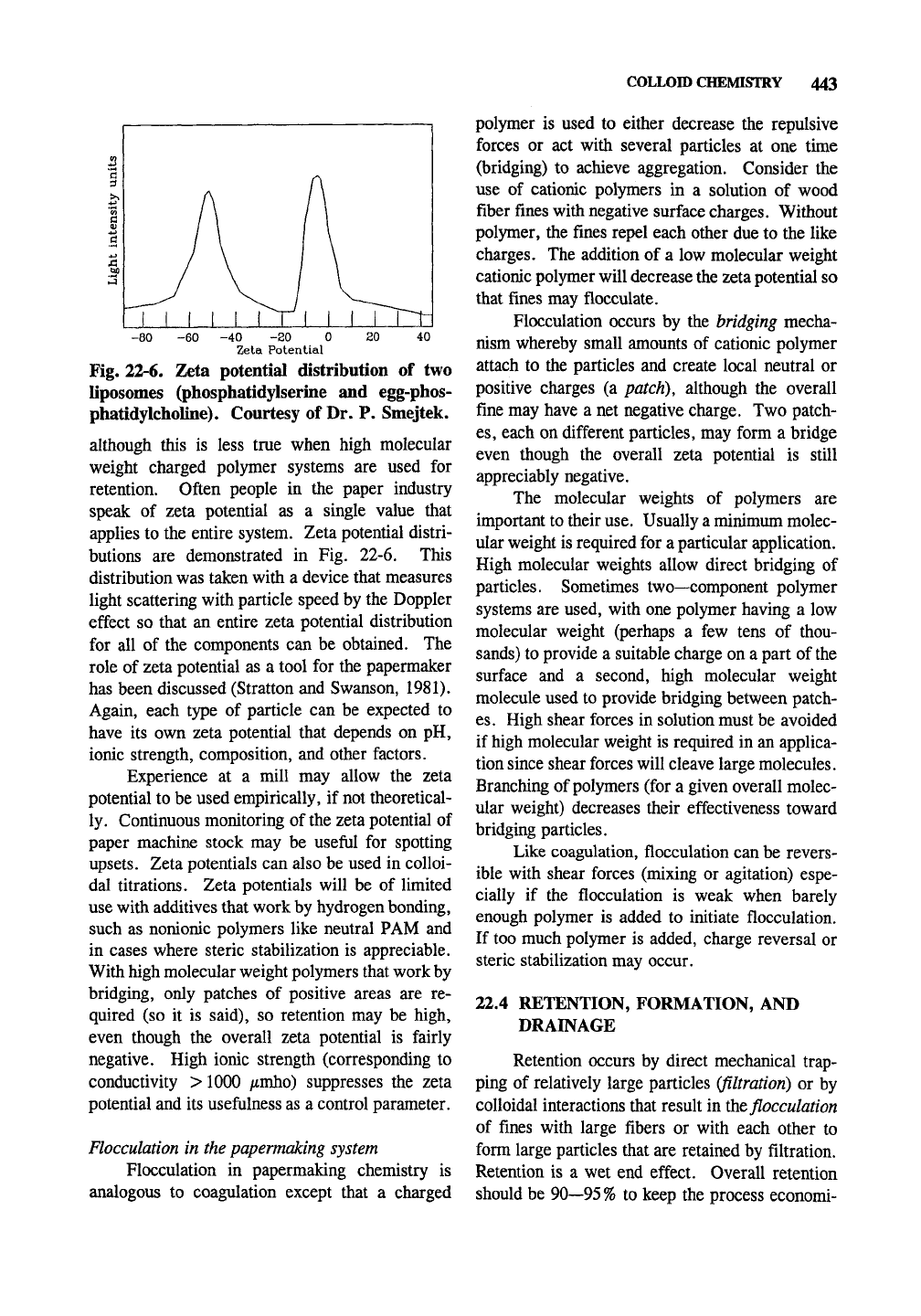
COLLOID CHEMISTRY 443
-60
-40 -20 0
Zeta Potential
Fig. 22-6. Zeta potential distribution of two
liposomes (phosphatidylserine and egg-phos-
phatidylcholine). Courtesy of Dr. P. Smejtek.
although this is less true when high molecular
weight charged polymer systems are used for
retention. Often people in the paper industry
speak of zeta potential as a single value that
applies to the entire system. Zeta potential distri-
butions are demonstrated in Fig. 22-6. This
distribution was taken with a device that measures
light scattering with particle speed by the Doppler
effect so that an entire zeta potential distribution
for all of the components can be obtained. The
role of zeta potential as a tool for the papermaker
has been discussed (Stratton and Swanson, 1981).
Again, each type of particle can be expected to
have its own zeta potential that depends on pH,
ionic strength, composition, and other factors.
Experience at a mill may allow the zeta
potential to be used empirically, if not theoretical-
ly. Continuous monitoring of the zeta potential of
paper machine stock may be useftil for spotting
upsets. Zeta potentials can also be used in colloi-
dal titrations. Zeta potentials will be of limited
use with additives that work by hydrogen bonding,
such as nonionic polymers like neutral PAM and
in cases where steric stabilization is appreciable.
With high molecular weight polymers that work
by
bridging, only patches of positive areas are re-
quired (so it is said), so retention may be high,
even though the overall zeta potential is fairly
negative. High ionic strength (corresponding to
conductivity >1000 ftmho) suppresses the zeta
potential and its usefulness as a control parameter.
Flocculation in the papermaking system
Flocculation in papermaking chemistry is
analogous to coagulation except that a charged
polymer is used to either decrease the repulsive
forces or act with several particles at one time
(bridging) to achieve aggregation. Consider the
use of cationic polymers in a solution of wood
fiber fines with negative surface charges. Without
polymer, the fines repel each other due to the like
charges. The addition of a low molecular weight
cationic polymer will decrease the zeta potential so
that fines may flocculate.
Flocculation occurs by the bridging mecha-
nism whereby small amounts of cationic polymer
attach to the particles and create local neutral or
positive charges (a patch), although the overall
fine may have a net negative charge. Two patch-
es,
each on different particles, may form a bridge
even though the overall zeta potential is still
appreciably negative.
The molecular weights of polymers are
important to their
use.
Usually a minimum molec-
ular weight is required for a particular application.
High molecular weights allow direct bridging of
particles. Sometimes two—component polymer
systems are used, with one polymer having a low
molecular weight (perhaps a few tens of thou-
sands) to provide a suitable charge on a part of the
surface and a second, high molecular weight
molecule used to provide bridging between patch-
es.
High shear forces in solution must be avoided
if high molecular weight is required in an applica-
tion since shear forces will cleave large molecules.
Branching of polymers (for a given overall molec-
ular weight) decreases their effectiveness toward
bridging particles.
Like coagulation, flocculation can be revers-
ible with shear forces (mixing or agitation) espe-
cially if the flocculation is weak when barely
enough polymer is added to initiate flocculation.
If too much poljnner is added, charge reversal or
steric stabilization may occur.
22.4 RETENTION, FORMATION, AND
DRAINAGE
Retention occurs by direct mechanical trap-
ping of relatively large particles (filtration) or by
colloidal interactions that result in
\h&
flocculation
of fines with large fibers or with each other to
form large particles that are retained by filtration.
Retention is a wet end effect. Overall retention
should be 90—95% to keep the process economi-
